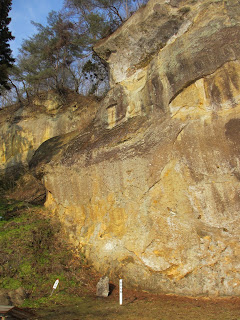 |
| Takkoku no Iwaya |
The
history of Hiraizumi did not start with the Fujiwaras. Japanese civilization developed to the south (where Kyoto was the capital), and for thousands of years northern Japan was a frontier region, full of hardbitten warriors, turbulent clans and restive peasants. Even during Hiraizumi's heyday, it was a frontier (since the court of Kyoto only controlled it in theory).
Today Japan is one of the least ethnically diverse places in the world: but originally the Japanese were immigrants. The original inhabitants of the islands were a pale-skinned, hairy people (typically sporting full beards, something that is not possible for many Japanese men): in fact, they look Caucasian (though according to DNA analysis they are not). They are known as the Ainu.
The Japanese fought with them for centuries, gradually pushing them up into the farthest reaches of the north (today they live only in Hokkaido); they have also been discriminated against for centuries (and in fact, their existence is not really acknowledged by the Japanese government even today, as it contradicts various important national myths).
These battles raged around Hiraizumi: around 800 AD, the military leader Sakanoue no Tamuramaro was sent from Kyoto by the court to defeat the Ainu in the region for good. He succeeded, and commemorated his victory with the construction of this temple. Its design mimics a temple in Kyoto and it was built directly on the site of the Ainu chieftain's fortress (the Ainu are not Buddhist). In other words, it served a function of social control and cultural domination.
 |
| Series of torii leading to the temple complex |
 |
| I love torii: there is something very magical about the concept of a gate between the mundane and spirit worlds |
 |
| The fortress was in a cave; now the temple is |
 |
| Backside of the temple |
 |
| A Buddha's face is carved into the cliff: it's the northernmost in Japan |
 |
| Closeup of the face |
 |
| The temple is (appropriately) dedicated to the god of war: here's some sword offerings |
 |
| This tree looks fake because it's so carefully groomed |
 |
| The temple is out in the countryside: here's a traditional Japanese house next door (the dwelling for the priest maybe?) |
Interestingly, the actual temple glosses over all this history: for instance, the chieftain is called a "bandit leader". It reminds me very much of certain elements in the relationship between the US government and Native Americans. For example, when Tamuramaro defeated the Ainu leader Aterui he was convinced to surrender with all his warriors under the promise of safety; then the government reneged and he was publicly executed in Kyoto (over the protests of Tamuramaro).
No comments:
Post a Comment